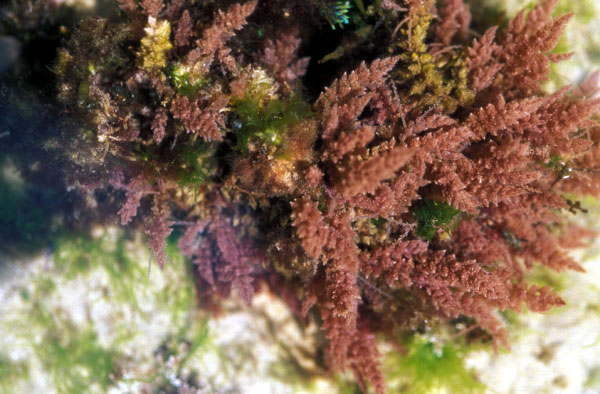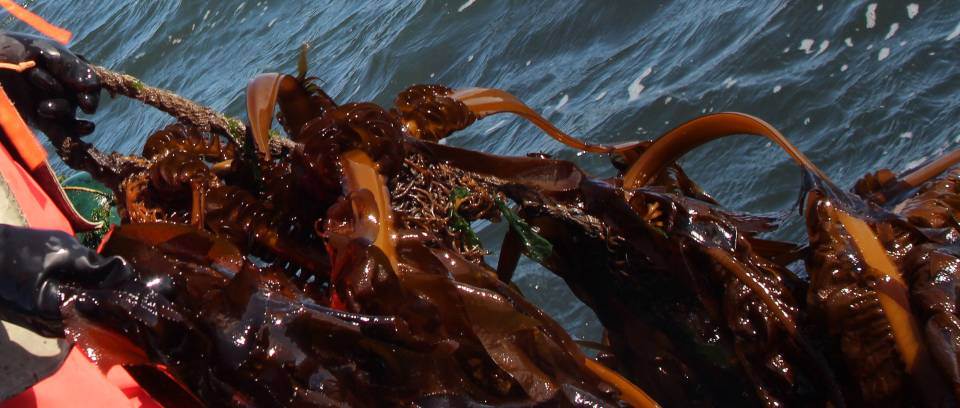The seaweed industry in India is mainly a cottage industry and is based only on the natural stock of agar yielding red seaweeds, such as Gelidiella acerosa and Gracilaria edulis, and algin yielding brown seaweed species such as Sargassum,and Turbinana. India produces 110-132 t of dry agar annually utiliziog about 880-1100 t of dry agarophytes and 360-540 t of algin froln 3 600-5 400 t of dry alginophytes.
Digital library
-
-
Plants interact with the environment by sensing “non-self” molecules calledelicitors derived from pathogens or other sources. These molecules bind to specificreceptors located in the plasma membraneand trigger defense responses leading toprotection against pathogens. In particular,it has been shown that cell wall and storagepolysaccharides from green, brown and red seaweeds (marine macroalgae) correspondingto ulvans, alginates, fucans, laminarin andcarrageenans can trigger defense responses inplants enhancing protection against pathogens. In addition, oligosaccharides obtained bydepolymerization of seaweed polysaccharidesalso induce protection against viral, fungaland bacterial infections in plants. In particular, most seaweed polysaccharides and derivedoligosaccharides trigger an initial oxidative burst at local level and the activation ofsalicylic (SA), jasmonic acid (JA) and/or ethylene signaling pathwaysat systemic level.The activation of these signaling pathways leads to an increased expression of genesencoding: (i) Pathogenesis-Related (PR) proteinswith antifungal and antibacterial activities;(ii) defense enzymes such as pheylalanine ammonia lyase (PAL) and lipoxygenase (LOX)which determine accumulation of phenylpropanoid compounds (PPCs)and oxylipins withantiviral, antifugal and antibacterial activities andiii) enzymes involved in synthesis ofterpenes, terpenoidsand/or alkaloids having antimicrobial activities. Thus, seaweedpolysaccharides and their derived oligosaccharides induced the accumulation of proteinsand compounds with antimicrobial activities thatdetermine, at least in part, the enhancedprotection against pathogens in plants.
-
People have been eating fresh and sun-dried seaweeds for health purposes in oriental countries for thousands of years. However, in recent years, many new compounds with medicinal values have been identified in different types of seaweeds. Interestingly, most of these pharmaceutical compounds and nutraceuticals come from traditionally edible seaweeds like nori, kombu, wakame and hiziki.
-
This manual is designed for farmers, buying agents, exporters and fisheries officers who play an important role in achieving the required quality of seaweed for export. The purpose of the manual is to educate farmers to understand the importance of good-quality seaweed, the role they play and the benefits they can achieve. The manual also provides guidance for buying agents, exporters and fisheries officers in the roles they perform to improve and maintain the required quality of seaweed.
-
Seaweeds (a plant group of the sea) in botanical terms "Algae" form an important food item in many countries of the East as well as West. In China, marine algae bears the name sea-vegetable and it is not uncommon for coastal inhabitants of Japan, Malaya, China and Phillippines to be seen on the seashore during low tide collecting these sea-vegetables. Korea and Japan are the two ceuntries where algae are farmed but only in Japan extensive seaweed cultivation is done.
-
Seaweeds are macroscopic algae, which form an important component of the marine living resource. They are available largely in shallow coastal waters wherever there is a substratum on which they can grow and flourish. Based on their pigmentation, the seaweeds are broadly grouped into green, brown, red and blue-green algae. They are harvested by man for centuries, particularly in Japan and China, where they form a part of the staple diet. The uses of seaweeds as food, fodder and manure are well known in many countries. Marine algae contain more than 60 trace elements in a concentration much higher than in terrestrial plants. They also contain protein, iodine, bromine, vitamins and substances of stimulatory and antibiotic nature.
-
Resource assessment surveys carried out by the Central Salt and Marine Chemicals Research Institute, Bhavnagar and by the Central Marine Fisheries Research Institute, Kochi indicate nearly 10000 to 19000 tonnes (wet biomass) of standmg crop of seaweeds are available in 12 atolls of the Laccadive Archipelago. comprising 114 species belonging to 62 genera. Of these resources, 25% of the standing crop of seaweeds are commercially important and can be exploited for the production of valuable phycocolloids such as agar-agar and alginic acid. The other 75% include edible and carrageenan yielding potential resources. These resources can be taped for industrial purposes either by regulated harvest or by attempting mariculture in the lagoon
-
Surveys were started by Central Marine Fisheries Research Institute during 1958 to estimate the available seaweed resources in the Mandapam area. Varma and Krishna Rao (1964) made two surveys (a preliminary one in 1958 and the other detailed one during 1 962-63), covering a total area of 234.25 sq km between Dhanushkodi and Hare island. The entire area surveyed was divided into 3 sections, namely Krusadai section. Hare Island section and Outside section. Since very little algae of economic value were present, the Outside section, was not taken into consideration.
-
Seaweeds are living and renewable marine resources which have tremenedous commercial importance. Seaweeds are macroscopic algae that grow in the littoral and sublittoral areas of marine environment when there is a suitable rocky or coral substratum.
-
This review of the seaweed resources of the world is part of a continuing programme of evaluating the resources from the sea of food, in a wide sense. These studies of the potential harvest are an important step towards the better planning of the proper use and management of these resources. The area breakdown is that used by FAO in compiling and publishing fishery statistics (see chart at end).
Quantitative studies of seaweeds are much rarer than those of fish stocks. The exceptions could be indicated by a few spots on the world map -the southwest coast of Norway,Scotland, Nova Scotia, the Californian kelp beds. The rest of the map is a blank space.This review is a first attempt to fill that space, but is primarily a challenge to field phyoologiBte to produce the data from which a better evaluation of the world's seaweed resources can be made.
Since this study concentrates on resource assessment, the potential harvest, and related quantitative studies, less emphasis has been given to studies on relative distribution, seasonal variation, mode of reproduction, etc. except where these are of direct interest to present or future utilization. However, for the areas for which suitable quantitative data are not yet available, ecological and similar information has been used to give an idea of the structure and composition of the flora, and thus provide a first approximation to the potential harvest.
Any study of this kind must distinguish between biomass (or standing st)cks) on the one hand and production or potential harvest on the other; further, a distinction needs to be made between the theoretically attainable harvest and that which is feasible in the light of practical and economic constituents.
Locally we often see the richest kelp pastures on plumb battered rooks, where no boat can stay in the breakers, or in the surf area, where no diver can find a holdfast. Uninhabited arctic and cold temperate areas may be extrem-ly rich in biomass, but even if collectors could be flown in from distant places, the transport costs for untreated seaweed or partly processed product put the resource out of all competition.
Rockweed of the genera Fucus and Cystoseira are among the richest producers if we estimate the bulk of seaweed in the ocean, but it is not yet solved how to use them. We know that certain laboratories study this problem, but have not yet seen their results being applied on on industrial scale. The same could be said about turtle grass, eel grass and other phanerogams, and mass occurrences of protein-rich Caulerpa green algae. A hindrance for the utilization of seaweeds in most areas is that they do not occur in single species stands but extremely mixed and entangled, often as epiphytes on each other.
Taken as a whole, seaweed resources are not greatly exploited. The potential for increasing the seaweed harvest depends as much on economic factors - the demand for the products and the costs of harvesting and processing - as on the overall biological production. Assuming no great changes - i.e. considering only the seaweed crops that consist of a sufficiently rich occurrence of a commercially attractive species occurring in areas where they can be really harvested, processed and marketed - the global production of the most important group, the red algae, could be increased by about 50 percent. The biomass of kelp and rockweed beds would permit a twentyfold increase in utilization of brown algae.
Several factors could act to support even greater expansion. On the production side seaweed harvesting can be labour-intensive; this could be a great advantage in the numerous developing countries where unemployment, and under-employment, are growing social problems on the marketing side, the continuing growth of world population will produce an increase in demand not only for direct food but also for the various other products in which many seaweeds are rich. The possibilities for expansion may be judged by the temporary boom of seaweed industries in many parts of the world in the early 1940s, when local seaweed production expanded to fill the gap left by the failure of supplies from abroad. changed balance of supply and demand a tenfold increase in present world harvest would not be unrealistic.
It is not the aim of this review to deal in detail with the technical and economic aspects of the processing and marketing of seaweeds, which have been discussed extensively Commercial products from seaweeds are encyclopedically treated Levring, Hope and Schmid (1969). Another section of the same handbook takes into separate consideration those species -seaweeds which are of interest as raw material or foodstuff. Further references can be found in "Selected Bibliography on Algae", issued by Nova Scotia Further references This has appeared with 13 Research Foundation, P.O. Box 790, Dartmouth, Nova Scotia. numbers containing references to scientific, technical and popular literature including most valuable sections on cultivation, utilization, economy, industrial methods and patents.
The economic and commercial aspects of seaweed utilization have been subject to remarkably few published investigations as compared to ecological and biochemical aspects. Haken (1958) gave a brief account of the major seaweed product industries in the mid-1950; a more recent review of the major seaweed products and their origin with data on industries and value was prepared by Silverthorne and Sorensen (1971).
Information on seaweed trade, prices, market trends and technical literature is iTU, regularly reported by International Seaweed Exchange, 24 Southwark Street, London, SEl in a market information bulletin, mainly intended for sellers and buyers transacting through the Exchange.
The Department of fisheries of FAO is presently undertaking a comprehensive review of the economic and commercial potential of the world's algaic resources, to be published as the study will examine trends in the production of seaone of its Commodity Study series; weeds and seaweed products, their utilization, trade and consumption. In progenting perspectives of likely future demand for such products it will try to indicate possible opportunities, particularly in the developing countries, for achieving higher levels of production and utilization.
A revision and updating of figures and statements in this paper is foreseen. are invited to send any comments and proposals to Aquatic Resources Survey and Evaluation Service, Fishery Resources and Environment Division, FAO, Rome, Italy, or directly to the author.





